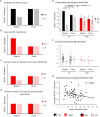Conjunctive Visual Processing Appears Abnormal in Autism
- PMID: 30713514
- PMCID: PMC6346680
- DOI: 10.3389/fpsyg.2018.02668
Conjunctive Visual Processing Appears Abnormal in Autism
Abstract
Face processing in autism spectrum disorder (ASD) is thought to be atypical, but it is unclear whether differences in visual conjunctive processing are specific to faces. To address this, we adapted a previously established eye-tracking paradigm which modulates the need for conjunctive processing by varying the degree of feature ambiguity in faces and objects. Typically-developed (TD) participants showed a canonical pattern of conjunctive processing: High-ambiguity objects were processed more conjunctively than low-ambiguity objects, and faces were processed in an equally conjunctive manner regardless of ambiguity level. In contrast, autistic individuals did not show differences in conjunctive processing based on stimulus category, providing evidence that atypical visual conjunctive processing in ASD is the result of a domain general lack of perceptual specialization.
Keywords: autism spectrum disorder; face processing; holistic; object recognition; sensory; vision; visual processing.
Figures


References
LinkOut - more resources
Full Text Sources
Other Literature Sources
Molecular Biology Databases

